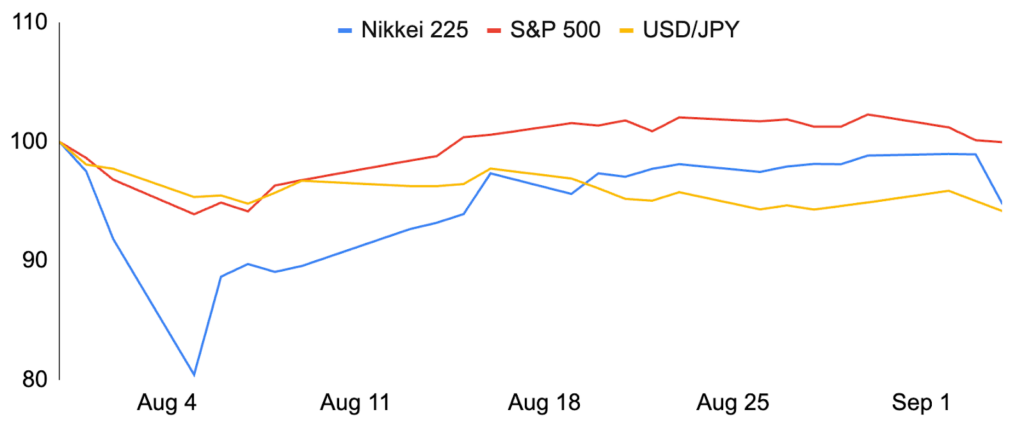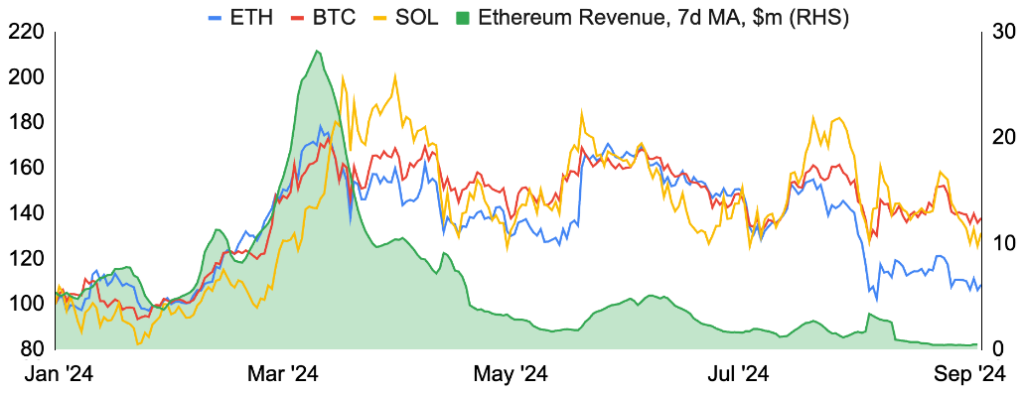Bitcoin and Ethereum
Bitcoin entered August around $64,600 and fell 9% during the month to $59,000. Crypto’s apex asset was not immune to the early-month traditional market plunge that was spurred by rising macroeconomic and geopolitical fears, with crypto further subject to additional idiosyncratic risks detailed below. While prices periodically bounced on better than feared economic data and dovish Fed commentary, Bitcoin struggled to recover with the equity markets due to mixed ETF flows, falling Trump victory odds, and worries of additional selling from various sources. Outside of market movements, BitGo diversified its wrapped Bitcoin (WBTC) custody by extending management to Justin Sun’s BiT Global, among others, prompting both MakerDAO to propose to reduce the growth of WBTC backing DAI and Coinbase to tease its own upcoming wrapped Bitcoin version, cbBTC. Elsewhere, 94% of Bitcoin’s supply has now been mined, and the US FBI responded to a freedom of information act request referring to Satoshi as a “third party individual”, a term typically reserved for non-US persons. Lastly, Bitcoin development made large strides during the month with announcements from Robin Linus, Stacks, Babylon, NEAR, Mezo, Tap Protocol, and Rebar, some of which are detailed more below.
Ethereum materially underperformed Bitcoin in August, entering the month around $3,250 and falling 22% to $2,500. While Ethereum was similarly impacted by the traditional market downturn and there was disappointment with still-subdued spot Ethereum ETF flows, the underperformance was likely primarily due to poor sentiment, as some see Ethereum as stuck between Bitcoin and Solana, and have openly begun to question Ethereum’s rollup strategy amidst falling fees. Positively, total ecosystem transactions continued to increase, though with the greater activity occurring on L2s and after Dencun’s increased data availability throughput, emissions continued to outpace the number of ETH burned, causing the ETH supply to increase by 54,500 during the month, or 0.5% annualized. Elsewhere, interoperability remained in focus, with Vitalik tweeting an L2 interoperability roadmap, Optimism announcing a universal interoperability standard for its Superchain, and Uniswap and Across proposing a new token standard for cross-chain intents. Further, debate raged as to whether Ethereum core developers care about DeFi, Sony announced the development of its Ethereum L2 Soneium, and Blocknative found that private transactions now represent 30% of all Ethereum mainnet transactions and 50% of all gas used. Lastly, Ethereum L2 Cronos zkEVM went live, EigenLayer introduced permissionless token support, and Arbitrum passed a proposal to enable ARB staking.
BTC and ETH

Source: Santiment, GSR.
Late Summer Market Meltdown
Traditional markets plummeted in early August due to three main reasons. First, the Bank of Japan raised interest rates at the end of July to combat the falling value of the yen, causing traders who borrowed yen-denominated loans at almost no cost to invest the proceeds elsewhere to unwind their yen carry trade positions, further pushing down asset prices and increasing the value of the yen. Second, worries around US economic growth grew after a series of data releases came in worse than expected, most notably July’s employment statistics. Finally, tensions in the Middle East rose after Iran vowed to get revenge for the assassination of a Hamas political leader, which some feared could lead to a larger war in the region. All in, Japan’s Nikkei 225 Index fell 18% in the five days ending August 5th and many large US tech stocks like Nvidia, Amazon, and Intel fell by 10% or more.
While crypto was certainly affected by the turmoil in the traditional markets, it also was subject to several negative idiosyncratic factors. One such factor was the dumping of hundreds of millions of dollars of cryptocurrencies, much of which was staked ETH, by a large market maker. In addition, the Mt Gox trustee sent $2.3b of Bitcoin to what is suspected to be BitGo to distribute to creditors, causing fears that creditors may sell their Bitcoin once received. Further, there was additional uncertainty as the US government transferred $600m of seized Silk Road Bitcoin to Coinbase Prime, with some believing the government is selling these assets. ETF flows also turned south, with the spot Bitcoin ETFs holding up well through the turmoil, but seeing $555m of outflows during three peak days of panic. And Trump’s Polymarket odds of winning fell from 72% after the mid-July assassination attempt to a virtual tie with Kamala Harris less than a month later, also weighing on prices. All in, despite a still-positive risk reward and multiple avenues for Bitcoin to hit $1m, Bitcoin fell to $49,200 early in the month, down 30% from nearly $70,000 just a week earlier, while Ethereum fell below $2,200, down 35% over that same time.
August Select Traditional Market Performance (July 31 = 100)

Source: Yahoo Finance, GSR.
Ethereum at a Crossroads?
Ethereum’s fees have continued to fall as activity shifts to layer twos (L2s) and with greater data availability throughput post the Dencun upgrade, causing many to openly question whether Ethereum’s rollup centric roadmap is the correct path for Ethereum. As a reminder, Ethereum chose to optimize for decentralization and security at the expense of speed, and as such prioritizes particularly low hardware requirements for its node operators. This, combined with its first mover advantage, has caused Ethereum to be the most decentralized and secure smart contract blockchain, but resulted in low transaction throughput, constrained blockspace, and high transaction costs. To remedy, Ethereum moved towards a rollup centric roadmap, which pushes execution to layer 2s that execute transactions off-chain and then prove valid execution back to Ethereum to not only significantly increase overall transaction throughput but also enable L2s to inherit many of the security properties of Ethereum itself. Such a construct sees Ethereum cede its execution function to L2s (and optionally its data availability function to specialized DA layers), maintaining only its consensus and settlement roles, and transforms Ethereum from the world computer to the world settlement layer.
Those who believe Ethereum’s current path is flawed believe Ethereum is stuck between Bitcoin as the best monetary asset / store of value and Solana as the most performant, high-throughput blockchain. And despite solutions in development like shared sequencers, aggregation layers, and based rollups, they point to poor rollup interoperability as fragmenting state and liquidity, as well as currently heavy L2 trust assumptions that may never be remedied given L2 incentives. They also worry about value capture, believing that Ethereum, now performing only consensus, settlement, and optionally DA, is ceding economics to DA layers and rollups in particular, the latter of which have their own state, users and dapps, and are also able to extract MEV. Here, they question the value of settlement and wonder whether L2s may use their own tokens for L2 gas, reducing ETH utility, or worse, whether key rollups will leave Ethereum altogether if they don’t receive enough of a benefit from being part of the ecosystem. Finally, they argue Ethereum’s strict maximization of decentralization at almost all costs is incorrect as it comes at the expense of functionality, performance, and value capture. As a result, some in this group want to see Ethereum make mainnet a more attractive place to transact rather than continue to optimize mainnet for L2s.
Conversely, others believe strongly in Ethereum’s rollup-centric roadmap and applaud Ethereum for effectively executing on its plan. Here, proponents believe that L2s are consistently making progress on their current shortcomings, and that Ethereum had to scale, else seed users to faster peers, that scaling via L2s is and was the most practical and fastest way to do so, and that L2 scaling comes with benefits scaling the L1 wouldn’t, such as allowing mainnet to ossify to enhance security and settlement guarantees while permitting innovation and experimentation to flourish on the L2s. Regarding value capture, this group tends to see it as an open question, believing settlement could potentially command the most economics with such decentralized and secure systems difficult to create, that lowering transaction costs will result in greater volumes that more than make up for the lower fees, and that Ethereum’s export of ETH to L2s increases its value as a monetary asset. Finally, this group believes that decentralization is the correct variable to optimize for, as surety around future state transitions is paramount and without it, one is essentially left with what amounts to an inefficient, centralized database.
While these views are certainly at odds, the good news is that all parties have Ethereum’s best interests in mind, candid dialogue has begun, and as an open source ecosystem, the best ideas from the community will be implemented. Already, there are significant research efforts focused on significantly reducing block times, raising the gas limit, exploring MEV-reducing multiple concurrent proposers, and moving to a based rollup construct that would allow L2s to inherit mainnet’s security guarantees, solve interoperability issues, and accrue value back to L1 validators. These and other upgrades can help with concerns from both parties, and it is now up to the Ethereum community to choose its path forward.
Ethereum Network Revenue vs. Token Performance (Dec 31, 2023=100)

Source: Artemis, Santiment, GSR.
Bitcoin Development
August was a notable month for Bitcoin development, with three particularly important items. First, Robin Linus released BitVM2, the second iteration of his method enabling arbitrary computation on Bitcoin without requiring a soft fork. BitVM functions similarly to an optimistic rollup, where computation occurs off-chain and Bitcoin itself can verify that the computation was done correctly. Relative to the first version, BitVM2 reduces the process from over 70 transactions to just three, while it also allows anyone to challenge suspicious transactions, not just a fixed set of operators. In addition to BitVM2, OG Bitcoin L2 Stacks began its two-week Nakamoto upgrade, which will reduce settlement times on Stacks from 10 minutes to 5-10 seconds and enhance security by making Stacks transactions as permanent as those on Bitcoin. Stacks’ Nakamoto upgrade also sets the stage for its coming sBTC upgrade that will reduce the trust assumptions when bridging BTC to Stacks by employing crypto-economic game theory and an open, dynamic set of signatories. Lastly, Bitcoin staking protocol Babylon launched its phase-1 mainnet to enable proof-of-stake blockchains to rent economic security from Bitcoin holders rather than procure a validator set and issue high inflationary rewards. Here, Bitcoin holders lock their Bitcoin in self-custodial vaults to earn yield while assuming slashing risk, and Babylon notably uses novel solutions such as extractable one-time signatures and timestamping for enhanced security. Overall, while Bitcoin L2s and staking solutions can make $1.2T of idle Bitcoin productive and capitalize on Bitcoin’s leading security and decentralization, these developments are particularly notable as they help solve the massive trust issues typically inherent in past solutions that often amounted to federated multisig solutions, thus offering high hopes for a step-change in Bitcoin functionality and usage.
The Permissionless BitVM Bridge Design

Source: BitVM.org, GSR.
GSR in the News
- The Block – WATCH LIVE: Experts discuss the crypto market crash on The Crypto Beat
- Bloomberg – ‘It Hurts Confidence:’ Volatility Upends Happy Crypto Narrative
- Blockworks – Are we back? Taking stock after last weekend’s crypto market turmoil
- Unchained – Has Decentralized Finance Hit Bottom?
- CoinDesk – The Anatomy of a Meltdown (and Just BTFD)
- DL News – When will Bitcoin’s price bounce back? Four experts on what will happen next
- The Information – The Rise of Crypto’s Shadow Bankers
- Forbes – Stay Selective During Alt Season (August Issue)
- Bloomberg – Cryptocurrencies Claw Back Losses as Ether ETF Investors Buy Dip.
- DL News – Where Ethereum’s price is headed next after worst month in over two years
Authors:
Brian Rudick, Senior Strategist | Twitter, Telegram, LinkedIn
Carlos Guzman, Research Analyst | Twitter, Telegram, LinkedIn
Toe Bautista, Research Analyst | Twitter, Telegram, LinkedIn
